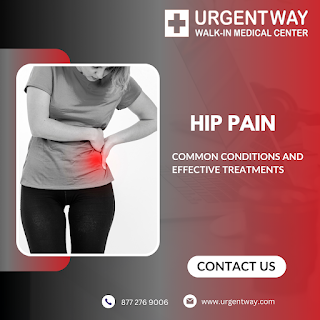Hip Pain: Common Conditions and Effective Treatments
If you’re feeling discomfort in your thigh, buttocks, groin, or the inside or outside of your hip joint, you want relief. Hip pain can be caused by a variety of conditions. If rest, ice, heat, and over-the-counter medications don’t help, you need expert help. Hip pain can be debilitating, affecting mobility and quality of life. Whether it's due to injury, wear and tear, or underlying medical conditions, understanding the causes and available treatments is crucial for effective management.
Understanding Hip Anatomy: Before delving into specific
conditions, it's essential to understand the anatomy of the hip joint. The hip
joint is a ball-and-socket joint, where the rounded head of the femur fits into
the acetabulum of the pelvis. It's surrounded by muscles, tendons, ligaments,
and cartilage, all of which work together to provide stability and facilitate
movement.
Common Causes of Hip
Pain:
- Osteoarthritis:
Osteoarthritis is a degenerative joint disease characterized by the
breakdown of cartilage in the joints. When it affects the hip joint, it
can cause pain, stiffness, and decreased range of motion. Factors such as
age, genetics, obesity, and previous hip injuries can contribute to the
development of osteoarthritis.
- Bursitis:
Bursitis occurs when the bursae, small fluid-filled sacs that cushion the
bones, tendons, and muscles near joints, become inflamed. Hip bursitis
typically causes pain on the outside of the hip that worsens with movement
or pressure. Repetitive activities or direct trauma to the hip can lead to
bursitis.
- Tendinitis:
Tendinitis refers to inflammation or irritation of the tendons, which are
thick cords that attach muscles to bones. In the hip, tendinitis often
affects the iliotibial band (IT band) or the tendons surrounding the hip
joint. Overuse, muscle imbalances, and poor biomechanics can contribute to
the development of tendinitis.
- Labral
Tears: The labrum is a ring of cartilage that lines the rim of the hip
socket, providing stability and cushioning to the joint. Labral tears can
occur due to injury, repetitive motion, or structural abnormalities in the
hip joint. Symptoms may include hip pain, clicking or locking sensations,
and limited range of motion.
- Hip
Fractures: Hip fractures are common among older adults and typically occur
as a result of a fall or direct trauma to the hip. Fractures can involve the
femur (thigh bone), pelvis, or acetabulum, leading to severe pain,
swelling, and difficulty bearing weight on the affected leg. Immediate
medical attention is crucial for proper diagnosis and treatment of hip
fractures.
Treatment Options:
- Conservative
Management: In many cases, hip pain can be managed conservatively through
a combination of rest, activity modification, and physical therapy.
Strengthening exercises, stretching routines, and modalities such as heat
or ice therapy can help alleviate pain and improve mobility.
- Medications:
Over-the-counter pain relievers such as acetaminophen or nonsteroidal
anti-inflammatory drugs (NSAIDs) may provide temporary relief from hip
pain associated with conditions like osteoarthritis or bursitis. In some
cases, corticosteroid injections may be recommended to reduce inflammation
and alleviate symptoms.
- Rehabilitation:
Physical therapy plays a crucial role in rehabilitating hip injuries and
improving strength, flexibility, and joint stability. A physical therapist
can tailor a personalized exercise program to address specific impairments
and promote optimal recovery.
- Minimally
Invasive Procedures: For certain conditions such as labral tears or severe
osteoarthritis, minimally invasive procedures such as arthroscopy or hip
resurfacing may be recommended. These techniques involve small incisions
and specialized instruments to repair damaged tissue or reshape the joint
surfaces, offering potential pain relief and improved function.
- Surgical
Intervention: In cases of advanced osteoarthritis or severe hip fractures,
surgical intervention may be necessary to restore joint function and
alleviate pain. Total hip replacement surgery involves removing damaged
bone and cartilage and replacing them with artificial implants designed to
mimic the natural hip joint.
Hip pain can have a significant impact on daily life, but
with proper diagnosis and treatment, most individuals can experience relief and
restore functionality. From conservative management strategies to surgical
interventions, a variety of options are available to address the underlying
causes of hip pain and improve overall quality of life. If you're experiencing
persistent hip pain or mobility issues, don't hesitate to consult with a pain management physician for personalized evaluation and treatment recommendations.




Comments
Post a Comment